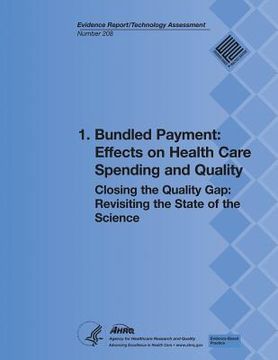Compartir
1. Bundled Payment: Effects on Health Care Spending and Quality: Closing the Quality Gap: Revisiting the State of the Science (Evidence Re (en Inglés)
U. S. Department of Heal Human Services
(Autor)
·
Agency for Healthcare Resea And Quality
(Autor)
·
Createspace Independent Publishing Platform
· Tapa Blanda
1. Bundled Payment: Effects on Health Care Spending and Quality: Closing the Quality Gap: Revisiting the State of the Science (Evidence Re (en Inglés) - And Quality, Agency for Healthcare Resea ; Human Services, U. S. Department of Heal
$ 34.20
$ 57.00
Ahorras: $ 22.80
Elige la lista en la que quieres agregar tu producto o crea una nueva lista
✓ Producto agregado correctamente a la lista de deseos.
Ir a Mis Listas
Origen: Estados Unidos
(Costos de importación incluídos en el precio)
Se enviará desde nuestra bodega entre el
Miércoles 14 de Agosto y el
Miércoles 21 de Agosto.
Lo recibirás en cualquier lugar de Internacional entre 1 y 3 días hábiles luego del envío.
Reseña del libro "1. Bundled Payment: Effects on Health Care Spending and Quality: Closing the Quality Gap: Revisiting the State of the Science (Evidence Re (en Inglés)"
This review is part of the Closing the Quality Gap: Revisiting the State of the Science series, which aims to provide critical analysis of the existing literature on quality improvement strategies for a selection of diseases and practices. The review focuses on "bundled payment," a strategy for health care quality improvement and cost containment. This strategy has been the subject of increasing interest, with the Centers for Medicare & Medicaid Services announcing a large national bundled payment initiative in August 2011. Other reviews in the series will address a range of quality improvement topics arising from portfolios (areas of research) of the Agency for Healthcare Research and Quality (AHRQ). We define "bundled payment" as a method in which payments to health care providers are related to the predetermined expected costs of a grouping, or "bundle," of related health care services. In contrast, fee-for-service payment typically involves payments for individual services, while capitation involves a single per capita prospective payment for all services over a fixed period of time, regardless of the number of services or episodes of care provided within that period. Within the bundled payment model, a variety of specific payment methods are possible. Bundles may be defined in different ways, covering varying periods of time and including single or multiple health care providers of different types. In addition, given the diversity and complexity of the U.S. health care delivery system, bundled payment programs may be implemented in a variety of contexts that may influence their effects on spending and quality. Bundled payment should create a financial incentive for providers to reduce the number and cost of services contained in the bundle. Providers are typically given discretion over the allocation of the services used to treat the patient's episode most effectively. This flexibility may encourage providers to use resources to coordinate care; often, these services are not reimbursed under fee-for-service payment. If the bundle includes services delivered by multiple providers in multiple settings, providers have to create a mechanism for managing the shared payment for a given treatment or condition, which could also foster coordination. Several types of undesired effects of bundled payment have also been postulated. The most significant potential undesired effects include underuse of effective services within the bundle, avoidance of high-risk patients, and an increase in the number of bundles reimbursed (increasing health spending). Providers under bundled payment may "game" the system by changing coding practices to maximize reimbursement for the bundle ("upcoding") or by moving services in time or location to qualify for separate reimbursement ("unbundling"). This review was designed to address the uncertainties about the effects of bundled payment on spending and quality measures. It should help readers (1) understand what the evidence shows about the effects of bundled payment on health care spending and quality of care, and (2) understand key design and contextual features of bundled payment programs and their association with bundled payment effects. The review addressed three Key Questions: 1. What does the evidence show on the effects of bundled payment versus usual (predominantly fee-for-service) payment on health care spending and quality measures? 2. Does the evidence show differences in the effects of bundled payment systems by key design features? 3. Does the evidence show differences in the effects of bundled payment systems by key contextual factors?

